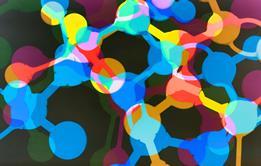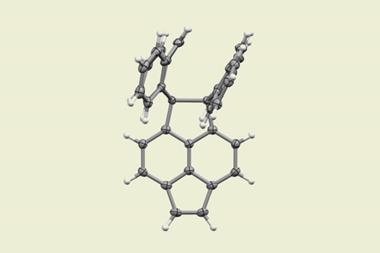Ionic, covalent, metallic and more… but there’s debate about whether bonds are real at all

There is something strange about the chemical bond. It is very difficult to define in a more sophisticated way than as being the ‘glue’ that ‘binds’ atoms. And yet the bond is one of the most essential concepts in chemistry; without it one cannot describe how molecules are structured, nor explain how a chemical reaction occurs.
Or so you’d think! Ambiguities around the nature of the chemical bond and borderline cases that fail to clearly fall under a particular type of bonding may be evidence that bonding and its types are merely conceptual constructs.
Chemists have developed an extensive classification system for bonds which includes not only the classic duo of ionic and covalent bonds, but also metallic, hydrogen, multi-centre bonds and more. While the classificatory scheme has proved extremely successful, a careful look at the definitions that characterise each type of bond shows that the nature of bonding is identified with strikingly different things. For example, in the context of the ionic bond it refers to ‘electrostatic attraction’, in that of covalent bonds it refers to ‘a region of high electron density’, and in that of hydrogen bonds it refers to ‘a form of association’.
There is no uniform description that could explain the nature of bonds and at the same time encompass all posited types of them. Philosopher Michael Weisberg notes that there is an ‘uncertainty or maybe even ambivalence about the status of the chemical bond itself’.1 So is this a problem?
Two conceptions of the chemical bond
Fortunately philosophy thrives on curiosity, especially of the conceptual kind! The most influential contribution so far is that of philosopher Robin Hendry with his 2008 paper ‘Two conceptions of the chemical bond’.2 Hendry proposes two ways to understand the chemical bond, namely via the structural and the energetic conception.
The structural conception is designed to capture the classical notion of the bond as it was developed by chemist Gilbert Lewis when he posited the covalent bond. Lewis defined the covalent bond in terms of an electron pair connecting two nuclei. In light of his idea and of the function bonds play in classical chemical formulae, Hendry’s structural conception takes bonds to refer to ‘material parts of the molecule that are responsible for spatially localised submolecular relationships between individual atomic centres’.
On the other hand, the energetic conception is designed to capture what was discovered about the bond through the study of quantum mechanics. Most notably, this includes the role of delocalisation effects in the stability of bonds, as well as the insight of how important energetic facts are to understanding why a bond is formed during a transformation. So, the energetic conception defines bonding as ‘facts about energy changes between molecular or supermolecular states’.2 It is on this basis that Hendry states that the energetic conception is ‘more a theory of chemical bonding than a theory of bonds’.
Notice a striking difference between the two conceptions: the energetic conception does not talk of bonds as material entities but refers to bonding as a state of a stable molecule. This implies that there are different ontological categories into which bonds can fall. In the case of the structural conception, they are viewed as things just like boxes and chairs. In the case of the energetic conception, they can be viewed as states or properties of things, just like whiteness and roundness.
Since the publication of Hendry’s paper, several interesting discussions have unfolded. First, the paper prompted a debate about which of the two conceptions more accurately captures the nature of bonds. While Hendry did not explicitly intend to present the two conceptions as competing with each other, Weisberg made critical points against the structural conception, arguing in favour of the energetic one. His arguments consider empirical facts about bonds that emerged through their analysis by quantum models. According to Weisberg, most quantum models show that a classical conception of the bond as a directional and localisable thing between atoms is not in line with what standard quantum models tell us about bonding.
To be or not to be?
A second issue concerns the reality of bonds. In general, the issue of scientific realism, namely of whether unobservable entities posited by science exist independently of us conceiving them, has been one of the most popular ones in philosophy of science. This issue can be raised for chemical bonds: do these unobservable entities exist? This question has interested philosophers and scientists alike. In fact, major figures in chemistry, such as Lewis and Charles Coulson, have expressed strong realist and antirealist views respectively.
More recently, chemist Mark Eberhart argued that we should stop talking of ionic, metallic and covalent bonds as this impedes the progress that is made by using quantum mechanics.3 He claims that chemists often try to explain chemical phenomena by reference to certain types of bonds; a practice that does not always help explain those phenomena.
As an example he discusses the properties of transition-metal carbides that some scientists tried to explain by reference to ionic bonds and others to covalent ones. In his view, the endeavour to form chemical explanations based on these classic classificatory schemes – while once extremely successful – nowadays can lead to confusing or unclear explanations. Given this, he concludes that thinking in terms of ionic, covalent or other types of bonds compromises ‘the usefulness of quantum mechanics in the synthesis and design of new molecules and materials’.
An idealisation or a vague concept?
While Eberhart does not explicitly endorse an antirealist view, there are several ways one can do so. First, one could reject altogether that distinct kinds of bonds exist. On this view, there are no ionic, covalent or metallic bonds in nature; these are just conceptual constructs that are employed for explanatory purposes.
A more nuanced stance is to take types of bonds to be idealised representations of bonds. Science employs idealisations of this sort extensively; namely, descriptions of systems or states that are knowingly (and intentionally) false, or in some sense distorted. Newtonian mechanics posits frictionless planes, thermodynamics posits elastic molecules, and so on. Similarly, chemistry posits covalent and ionic bonds. This view is supported by the fact that there is no clear-cut distinction between these two types. Instead, the two are often viewed as the extremes of a continuum about bonding. This also fits well with the functions different types of bonds serve. Just like other idealisations, types of bonds serve cognitive purposes: they are used in learning, understanding and explaining chemical phenomena. They are representationally simple and handy as heuristic devices.
Another notion from philosophy that may shed light on bonding is vagueness. The key indicator of a concept being vague is that it has borderline cases. Again, here we can find examples that indicate vagueness in the different types of bonds. Take borderline hydrides. These are molecular entities composed of anions of hydrogen and thallium, indium or elements of group 11 or 12. Borderline hydrides exhibit properties that are suggestive of both ionic and covalent bonding, making it difficult to classify their bonds in either of the two categories.
Real patterns
Despite these antirealist suggestions, all is not lost for the realist. For example, I have defended the view that bonds are patterns of interactions between subatomic particles.4 This is based on the seminal work on patterns developed by philosopher Daniel Dennett and then further developed by (among others) philosophers James Ladyman and Don Ross.
Dennett proposes that a pattern exists when something can be described in a simplified way.5 For the case of bonds Dennett’s reasoning can be applied as follows. In principle, quantum mechanics can describe a stable molecule by identifying the interactions of every subatomic particle that makes it up. But one could also offer a chemical description of the molecule by identifying the atoms and the bonds between them. This is suggestive of a pattern in the way subatomic interactions occur in a stable molecule. Given that to characterise that pattern one invokes chemical bonds, it follows that bonds are real.
The advantage of this account is that it allows us to believe in the existence of covalent, ionic and other types of bonds. To the extent that these are simplified descriptions of subatomic interactions, they qualify as depictions of patterns and are therefore real.
One can be a realist or an antirealist in vastly different ways
There are other advantages to understanding bonds as patterns, which in my view make this account even more appealing. First, it takes into account a crucial feature of bonds, namely that they are dynamic and diachronic entities. Despite their static representation as rods connecting atoms, they are formed by interactions of electrons and nuclei that move around in time.
Secondly, it offers a more precise understanding of how bonds relate to their constituents. In philosophy of science, how entities relate to their physical parts has been a persistent question with some philosophers claiming that entities entirely reduce to those parts (as opposed to having features that none of the parts have individually). This view is sometimes (falsely) taken to imply that nothing exists apart from the entities that are posited by physics. However, Ladyman and Ross propose composition to be understood in terms of patterns.6 This is a better way to construe composition because it allows us to be realists without having to deny that bonds are anything more than the result of their physical constituents and their interactions. In fact, it has an advantage over classic reductionism as the latter usually dismisses the reality of chemical stuff. It is also a better option over certain antireductionist views such as emergence or pluralism, as the latter would require chemical stuff to be in some way substantially different from their constituents.
All in all, there are many ways to construe bonds in a philosophically informed manner. One can be a realist or an antirealist in vastly different ways. Given that we will never agree on this, perhaps it is best to follow quantum chemist Roald Hoffmann who, in his 2009 keynote address to the International Society for Philosophy of Chemistry, said: ‘A bond will be a bond by some criteria and not by others … have fun with the concept and spare us the hype’.
References
1 M Weisberg, Philosophy of Science, 2008, 75, 932 (DOI: 10.1086/594536)
2 R F Hendry, Philosophy of Science , 2008, 75, 909 (DOI: 10.1086/594534)
3 M Eberhart, Foundations of Chemistry, 2002, 4, 201 (DOI: 10.1023/A:1020655631654)
4 V A Seifert, Philosophy of Science, 2023, 90, 269 (DOI: 10.1017/psa.2022.17)
5 D C Dennett, The journal of Philosophy, 1991, 88, 27 (DOI: 10.2307/2027085)
6 J Ladyman, D Ross, and D Spurrett, Every thing must go: Metaphysics naturalized. Oxford University Press, 2007

Bonds are the ties that bind chemistry

Those seemingly simple sticks belie our most complex concept
- 1
- 2
- 3
- 4
 Currently
reading
Currently
reading
Do bond classifications help or hinder chemistry?
- 6



























No comments yet